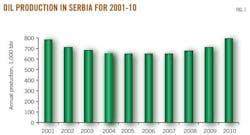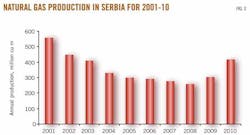Exploration, production pace faster in Serbia, Bosnia and Herzegovina
View Article as Single page
Oil and gas production in Serbia
Ninety percent of the discovered oil and gas reservoirs are in the northern part of Serbia, called Vojvodina, namely the Banat depression of the Pannonian basin. The other producing fields are in central Serbia, south of the Sava and Danube rivers.
Oil and gas exploration in Serbia began in 1947 and has included regional gravimetric, magnetic, and seismic surveys (41,000 line km-2D and 460 sq km-3D) and drilling of 2,032 exploration and development wells. The wells discovered 100 oil and gas fields with about 280 reservoirs.5
Most of the oil and gas fields in Vojvodina and central Serbia are small in terms of production rate.6 Exceptions are Velebit, Kikinda, Elemir, Mokrin, and Itebej fields that belong to the larger oil fields of the Pannonian basin and to the average on a European scale.
Most of the fields are in structural traps in Lower and Upper Pontian (Neogene) sediments. Many previous geological studies were focused on structural traps in underlying Tertiary sediments. Besides that trap type, some stratigraphic or lithological traps were accidentally discovered, and a large number of these nonconventional traps are in structures with negative hydrocarbon crests. Unconventional gas deposits have also been discovered in Vojvodina.
In central Serbia, small oil and gas reservoirs were discovered in Tertiary sediments.7 Petroleum production in this part of Serbia, which is considered insufficiently explored, began in 1990. The most recent geochemical studies identified Mesozoic-Paleozoic structures as potentially hydrocarbon-bearing.
Oil and gas production in Serbia peaked in the 1980s. Oil production declined until 2006 and gas production fell through 2009. Today, oil and gas are produced from 52 fields with 800 wells in 135 reservoirs.
The last large oil discovery, Turija-North, was in 1987. Since then, the several small, mostly gas-condensate reservoirs (Martonos-West, Martonos Farm, Chestereg, Melenci, etc.) were found.
In 2006 the oil production decline was stopped due to application of stimulation methods and production optimization.8 Compared with 2008, oil production rose 4% in 2009 and 12% in 2010 (Fig. 1).
Serbian natural gas production compared with 2008 was up 19% in 2009 and 30% in 2010 due to new field discoveries and improved reservoir management (Fig. 2).
Future production rates will depend mainly on the results of further exploration and application of new exploitation technologies.
Displaying 2/5
View Article as Single page


